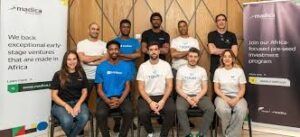UK-based autonomous drone company Sees.ai raised £3.65 million led by Boeing with participation from Sustainable Future Ventures, Hearst Ventures, Elbow Beach Capital, and WakeUp Capital—funding that follows the company becoming the first UK operator authorized by Civil Aviation Authority for routine Beyond Visual Line of Sight (BVLOS) drone flights.
Founded in 2018 by John McKenna and Damien Charveriat in Chichester, Sees.ai operates autonomous inspection drones for infrastructure including power grids, offshore wind farms, and oil and gas facilities. The company’s deployment with UK’s National Grid represents the world’s first large-scale BVLOS operations conducting inspections on live power infrastructure.
Boeing’s lead investment signals strategic interest from aerospace incumbents recognizing autonomous drone infrastructure as adjacent to traditional aviation markets. Boeing’s venture arm has backed autonomous aviation companies including Wisk Aero (raised $450 million for electric air taxis), indicating portfolio strategy targeting various autonomous flight applications.
CAA’s routine BVLOS authorization provides Sees.ai with operational advantages competitors cannot easily replicate. Most drone operations require visual line of sight or case-by-case waivers for beyond visual range flights. Routine authorization allows Sees.ai to conduct inspections without per-flight regulatory approvals—reducing operational friction and enabling commercial scale.
Achieving this approval required demonstrating collision avoidance capabilities, autonomous flight control reliability, and safety protocols satisfying aviation regulators. The investment and development required to meet CAA standards creates a barrier to entry for competitors lacking resources or technical capabilities.
Comparable US company Percepto secured nationwide BVLOS waiver from FAA after raising $67 million Series C, indicating regulatory approval requires substantial capital and technical investment. Sees.ai’s earlier regulatory success at smaller funding scale suggests either the UK regulatory environment is more permissive or the company achieved technical requirements more efficiently than competitors.
The National Grid partnership represents flagship customers providing validation for other utilities considering autonomous inspection adoption. National Grid operates transmission infrastructure across England and Wales, making it a reference customer for European grid operators evaluating similar technology.
Traditional powerline inspection uses helicopters ($1,000-2,000 per hour) or manual climbers accessing towers individually. Autonomous drones reduce costs through lower equipment expenses, faster inspection cycles, and reduced safety risks from helicopter flights or tower climbs.
The “live power infrastructure” specification matters critically. Conducting inspections without de-energizing lines avoids service interruptions and revenue loss for utilities. If Sees.ai’s technology enables safe inspections on active power lines, it delivers operational value beyond cost reduction—utilities can increase inspection frequency without scheduling outages.
Offshore wind farm inspections represent high-growth adjacent markets. Europe leads global offshore wind capacity with operational projects across the North Sea, Baltic Sea, and Atlantic coast. Wind turbine inspections currently use rope access technicians or helicopter-mounted cameras—expensive and weather-dependent methods autonomous drones can replace.
Oil and gas methane monitoring addresses environmental compliance requirements as European regulators tighten emissions standards. Drones equipped with methane detection sensors can identify leaks faster than ground-based inspection teams, enabling rapid response reducing emissions and regulatory penalties.
The geographic expansion strategy suggests Sees.ai operates a service model (conducting inspections for utilities) rather than pure software/hardware sales. Service models generate recurring revenue and deeper customer relationships but require scaling operational teams and drone fleets—capital intensive compared to software licensing.
Listed competitors include Civ Robotics, Percepto, and Cyberhawk Innovations. Percepto raised $67 million total funding and secured FAA BVLOS waiver, operating primarily in the US market. Cyberhawk provides drone inspection services without emphasizing autonomous BVLOS capabilities.
Sees.ai’s differentiation centers on autonomous flight control and collision avoidance enabling BVLOS operations without remote pilots. If competitors require human operators maintaining visual contact or controlling flights remotely, Sees.ai achieves superior cost structure through automation reducing labor requirements.
However, autonomous capability creates technical support and liability challenges. Software failures or sensor malfunctions during BVLOS flights could result in crashes affecting infrastructure, property, or public safety. The regulatory approval process likely required demonstrating redundancy, fail-safe mechanisms, and insurance coverage addressing these risks.
Boeing’s lead investment provides more than capital. The aerospace incumbent offers aviation certification expertise, supply chain relationships, regulatory affairs experience, and potential commercialization partnerships.
Boeing’s core business faces challenges from 737 MAX issues, supply chain disruptions, and competition from Airbus. Diversifying into autonomous aviation through venture investments allows Boeing to participate in emerging markets while maintaining focus on traditional commercial aviation.
For Sees.ai, Boeing’s involvement validates technology credibility with aviation regulators globally. Expansion into Europe and international markets requires satisfying various national aviation authorities. Boeing’s reputation and regulatory expertise could accelerate approval processes in new jurisdictions.
The relationship could also lead to technology licensing, joint ventures, or eventual acquisition if Sees.ai demonstrates commercial success. Boeing’s venture investments often precede strategic acquisitions of promising portfolio companies.
The £3.65 million round size suggests Series A or early growth stage financing. For autonomous drone operations, capital requirements include hardware procurement (drone fleets), software development (AI for collision avoidance and navigation), regulatory compliance (safety testing and certification), and market expansion (sales, operations, customer success).
The multi-market expansion plan across the UK and Europe requires establishing local operations, navigating different regulatory regimes, and building utility relationships in each country. Unlike pure software companies scaling through cloud infrastructure, service-oriented drone operations require physical presence and operational capabilities in each market.
Predictive maintenance AI development mentioned in plans indicates Sees.ai aims to provide analytics beyond inspection images. If AI can identify equipment degradation patterns and predict failures before occurrence, utilities can optimize maintenance scheduling—potentially more valuable than inspection cost reduction alone.
European infrastructure investment is accelerating driven by energy transition, aging grid modernization, and climate resilience requirements. The EU’s Green Deal includes substantial funding for renewable energy infrastructure requiring ongoing monitoring and maintenance.
Offshore wind capacity is projected to grow substantially across the North Sea region, creating an expanding market for turbine inspection services. Similarly, power grid expansion connecting renewable generation to consumption centers requires new transmission lines needing regular inspection.
This favorable macro environment supports Sees.ai’s growth trajectory. However, utility procurement cycles are lengthy—enterprise sales requiring 12-24 months from initial contact to commercial deployment. The National Grid reference helps accelerate sales cycles but doesn’t eliminate utility procurement complexity.
Investment Thesis Validation Requirements
For investors evaluating autonomous drone infrastructure companies, key metrics to monitor include:
Regulatory approvals: Additional country authorizations for BVLOS operations indicating technology meets safety standards.
Customer adoption rate: Utility companies deploying autonomous inspections beyond pilot projects to operational scale.
Unit economics: Cost per inspection versus traditional methods demonstrating sustainable margin structure.
Fleet utilization: Drone usage rates determining whether service model scales efficiently.
Technology reliability: Incident rates and safety record validating autonomous operation dependability.
Sees.ai’s National Grid deployment and CAA approval provide strong initial validation. The next 18-24 months will determine whether the company achieves European expansion targets and converts customer interest into commercial contracts generating returns justifying venture investment.








